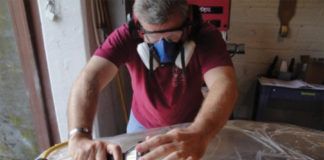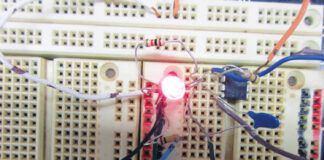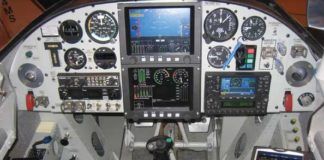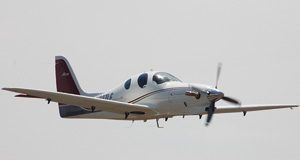Recently, we have been discussing various forms of aerodynamically driven vibrations and oscillations of airplane structures. So far, we have looked at various forms of flutter, all of which involve interactions between deflections of the structure and the aerodynamic forces acting on it. Classic flutter happens even in situations where the airflow is attached and steady. Sometimes, however, the source of the oscillating force and hence vibration is unsteady or fluctuating airflow. Separated or partially separated airflows can produce unsteady forces on the surface they are flowing over, or they can shed wakes that may cause unsteady forces on elements immersed in the wake. This type of aerodynamically induced shaking is called buffet.
Separated Flow
When the airflow separates from the surface, it forms an unsteady, turbulent wake downstream of the point of separation. The details of this separated wake vary depending on the configuration of the surface and the flow conditions, but all separated flows include relatively large-scale turbulence. The turbulence and unsteadiness of separated flow cause fluctuations in the aerodynamic forces on the surface that initiated the separation, and can also impose significant unsteady force on any surface that the wake impinges upon.
The buffet caused by separated flow can vary from mild to quite intense. In general, it is undesirable for an airplane to experience significant buffeting in steady-state cruise flight, though some buffet is acceptable during maneuvering flight or in special cases such as the deployment of a speed brake or spoiler.
Stall
A common form of separated flow on airplanes is the flow over the wing in a developing stall. As the wing starts to stall, the airflow separates over part of the wing. If the wing is properly designed, this separation begins near the root. The flow in the separated region becomes turbulent, and the lift generated by the wing fluctuates as a result. As the wing stalls, it can cause buffet two different ways. The first is the direct effect of the breakdown of the flow over the wing itself. The stalled flow imposes fluctuating forces on the wingskin that shake the airplane. As the wake of the stalled region of the wing flows downstream, it may also impinge on the horizontal tail. The unsteady flow in the wake can shake the tail and the elevators. On an airplane with a simple mechanical control system, the pilot will feel this tail buffeting in the controls.
Stall buffet is a case where the buffeting caused by flow separation is actually desirable. The buffet provides a natural cue to the pilot that warns of the impending stall. An airplane that exhibits significant stall buffet before the lift break is safer than one that stalls abruptly with little buffet to warn the pilot that the angle of attack is getting too high.
Bluff Bodies
A common source of unsteady airflow and buffet are bluff bodies with short or blunt aft portions. If the afterbody is rounded, and too short to maintain flow attachment, then separation will occur at some point upstream of the extreme aft end of the body. The nature of the flow aft of the point of flow separation depends on the shape of the body. On a rounded afterbody, the separation point is not as stable as it is on a chopped-off afterbody. On the latter, the flow always separates at the corner. On a rounded afterbody, the exact separation point is determined by the details of the flow including the angle of attack or sideslip of the body, and it can move around a lot. This can cause significant problems because each time the separation point moves, it changes the shape and position of the wake and may cause large changes in the aerodynamic forces on the body.
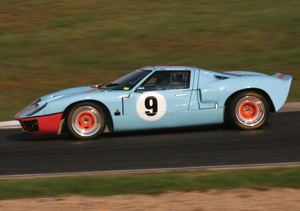
Blunt afterbodies have been used in auto racing for decades to improve stability. This Ford GT-40 has almost no taper to the rear of the body, capped by a small spoiler to induce some downforce.
There are two situations that can be particularly troublesome. The first occurs when the flow switches between one stable state and another. If the body has a small positive angle of attack, the flow on the lower side will stay attached well aft, and the separation point on top will move forward. This deflects the wake up and causes a nose-up moment. If the angle of attack is changed to slightly negative, the situation will reverse, with the separation point on top moving aft and the one on the bottom moving forward.
This switching phenomenon causes the body to be unstable because of the abrupt changes in the shape and position of the wake. The same thing can happen directionally in response to small yaw angles if the afterbody is too short. This has been a problem on some pod-and-boom pushers and amphibians where the flow switching not only affected the forces on the back of the pod, but caused large, unstable changes in the flow over the vertical fin. This flow switching can impose large, unsteady forces on both the body itself and any trailing surface that is affected by the separating flow. Tail surfaces that are in the wake of a too-bluff cabin or canopy are particularly susceptible. Even if the buffet is mild enough that it can be tolerated in flight, a steady-state buffet of a tail can lead to serious fatigue life issues because of the continuous cycling of the structure caused by even a relatively mild buffet.
A second form of flow instability in the wake of a blunt afterbody is periodic or oscillating flow. What happens is that, as the wake develops, it changes the airstream enough to cause the flow to switch as we saw above. The difference is that, once switched, the flow alters the airstream in a way that makes it switch back. The result is that the flow oscillates back and forth between the two states, and the body sheds periodic vortices or turbulent flow structures.
This is a situation that must be avoided on airplanes. The oscillating wake shedding causes large oscillatory forces on the body doing the shedding, and causes severe buffeting that can also trigger flutter. This is why it is a good idea to avoid using slender cylindrical components that will experience cross-flow on airplanes. The classic example of such a periodic wake phenomenon is called Von Karman Vortex Shedding, and it occurs when a cylinder is flying through the air sideways. This type of wake structure has caused problems not only on airplanes but on buildings and bridges when high winds set up the right flow conditions to cause vortex shedding.
Stop Shedding
One non-aviation example of Von Karman Vortex Shedding causing problems is what happens sometimes with large industrial chimneys. At certain wind speeds, the oscillating forces caused by the vortex shedding can shake the chimneys enough to cause them to fail. The solution that has evolved is a set of spiral strakes around the chimney that make it look like a gigantic drill bit. The flow separates at the edges of the strakes, and the separation point does not move. Although there is still some buffet due to the flow separation, it is much less than that caused by the periodic shedding of vortices on the basic cylindrical chimney. The advantage of the strakes is that they work no matter what direction the wind is blowing.
On an aircraft component that exhibits Von Karman Vortex Shedding, where the direction of the airflow is relatively constant, there is no need to spiral the trip strips. Properly located strips or vortex generators can reattach the flow or cause it to separate in a stable manner without significant oscillations.

![]()
Barnaby Wainfan is a principal aerodynamics engineer for Northrop Grummans Advanced Design organization. A private pilot with single engine and glider ratings, Barnaby has been involved in the design of unconventional airplanes including canards, joined wings, flying wings and some too strange to fall into any known category.










